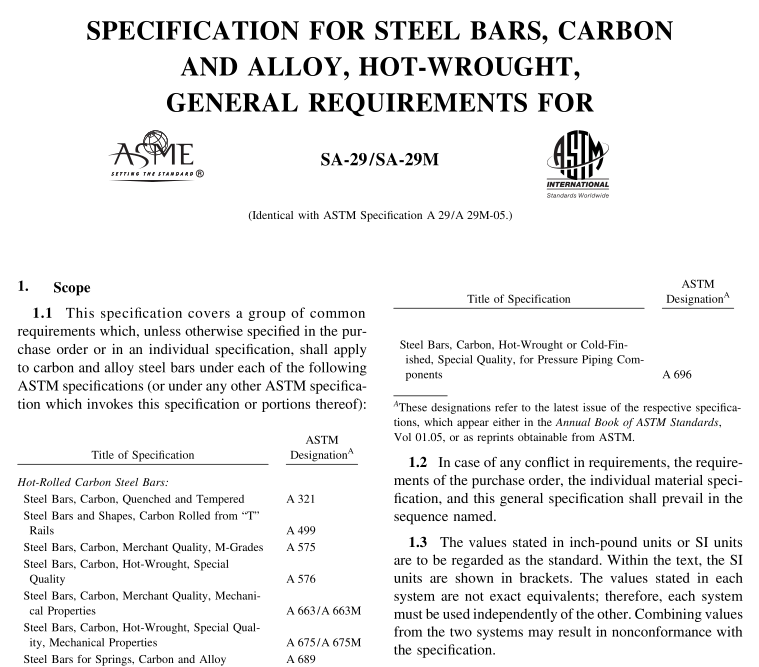ASME II SA29 pdf download

ASME II SA29 pdf download SPECIFICATION FOR STEEL BARS, CARBON AND ALLOY, HOT-WROUGHT, GENERAL REQUIREMENTS FOR
4.Chemical Composition4.1 Limits:
4.1.1 The chemical composition shall conform tothe requirements specified in the purchase order or theindividual product specifications.For convenience thegrades commonly specified for carbon steel bars are shownin Tables 1 and 2. Bars may be ordered to these gradedesignations and when so ordered shall conform to thespecified limits by heat analysis.
4.1.2 When compositions other than those shown inTables 1 and 2 are required, the composition limits shallbe prepared using the ranges and limits shown in Table 3for carbon steel and Table 4 for alloy steel.
4.2 Heat or Cast Analysis:
4.2.1 The chemical composition of each heat or castshall be determined by the manufacturer in accordancewith Test Methods,Practices,and Terminology A 751.
4.2.2 The heat or cast analysis shall conform to therequirements specified in the product specification or pur-chase order. These can be the heat chemical range andlimit for a grade designated in Tables 1 and 2, or anotherrange and limit in accordance with 4.1.2,or with require-ments of the product specification.
NOTE2—Heat analysis for lcad is not detcrminable since lcad is addedto the ladle stream while each ingot is poured,When specified as anadded element to a standard steel, the percentage of lead is reported as0.15 to 0.35 incl, which is the range commonly specified for this element.
4.2.3 If requested or required, the heat analysis shallbe reported to the purchaser or his representative.
4.2.4 Reporting of significant figures and roundingshall be in accordance with Test Methods,Practices,andTerminology A 751.
4.3 Product Analysis:
4.3.1 Merchant quality carbon bar steel is not subjectto rejection for product analysis unless misapplication ofa heat is clearly indicated.
4.3.2Analyses may be made by the purchaser fromfinished bars other than merchant quality representing eachheat of open-hearth, basic-oxygen, or electric-furnace steel.The chemical composition thus determined shall not varyfrom the limits specified in the applicable specification bymore than the amounts prescribed in Table 5 and Table 6,but the several determinations of any clement,excludinglead, in a heat may not vary both above and below thespecified range. Rimmed or capped steel is characterizedby a lack of homogeneity in its composition,especiallyfor the elements carbon, phosphorus, and sulfur; therefore,
when rimmed or capped steel is specified or required,the limitations for these elements shall not be applicable.Because of the degree to which phosphorus and sulfursegregate, the limitations for these elements shall not beapplicable to rephosphorized or resulfurized steels.
4.3.3 Samples for product analysis shall be taken byone of the following methods:
4.3.3.1 Applicable to small sections whose cross-sectional area does not exceed 0.75 in.3[500 mm3] suchas rounds, squares. hexagons,and the like. Chips are takenby milling or machining the full cross section of the piece.Drilling is not a feasible method for sampling sizes 0.75 in.2and smaller.
4.3.3.2Applicable to products where the width of
the cross section greatly exceeds the thickness, such as barsize shapes and light flat bars.Chips are taken by drillingentirely through the steel at a point midway between theedge and the middle of the section, or by milling or machin-ing the entire cross section.
4.3.3.3 Applicable to large rounds, squares semi-finished, etc.Chips are taken at any point midway betweenthe outside and the center of the piece by drilling parallelto the axis or by milling or machining the full cross section.In cases where these methods are not practicable, the piecemay be drilled on the side, but chips are not taken untilthey represent the portion midway between the outside andthe center.
4.3.3.4When the steel is subject to tension testrequirements, the tension test specimen can also be usedfor product analysis.In that case, chips for product analysiscan be taken by drilling entirely through the tension testspecimens or by the method described in 4.3.3.1.
4.3.4 When chips are taken by drilling, the diameterof the drill used shall conform to the following:









